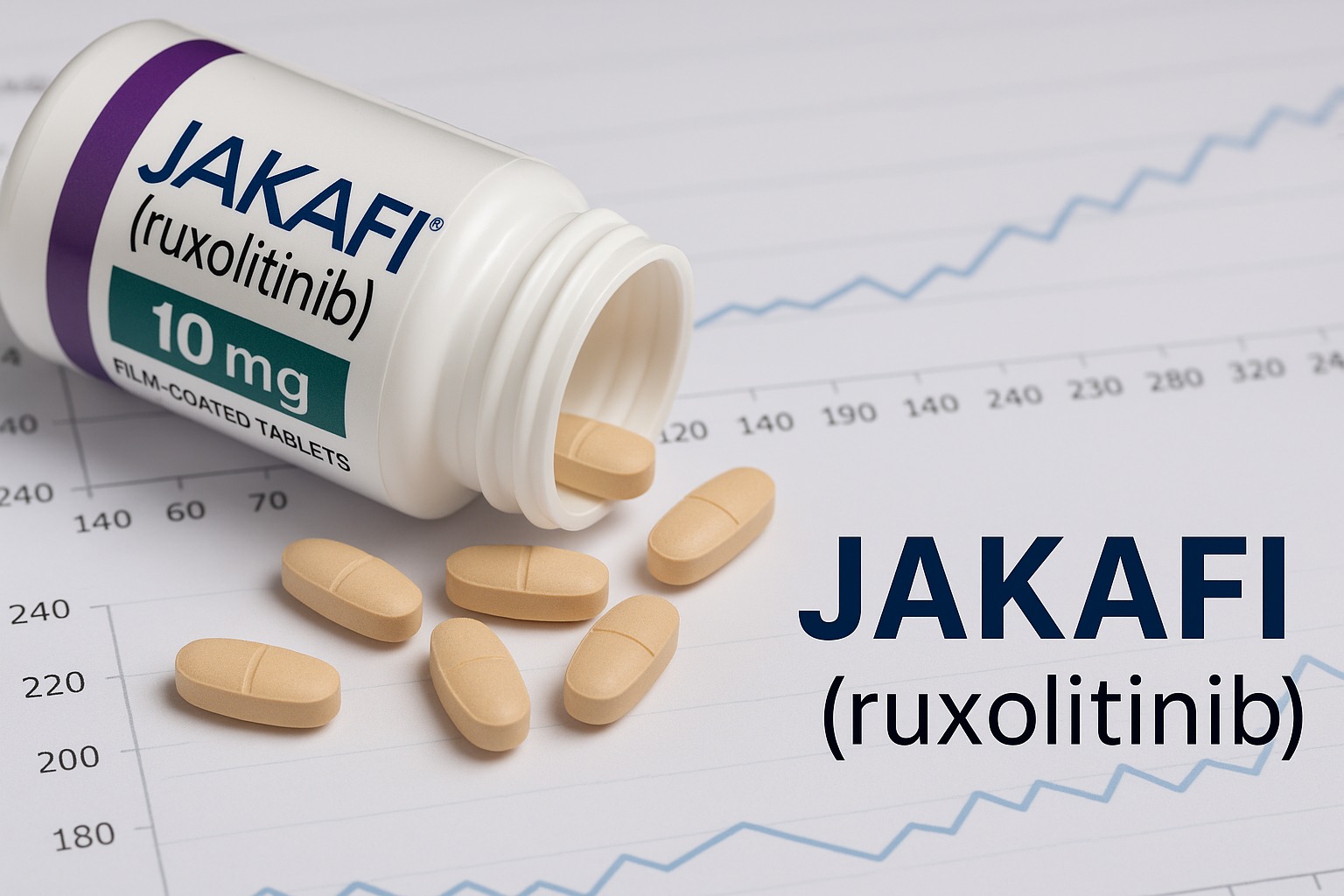Jakafi® (ruxolitinib) is an oral prescription medication belonging to the Janus kinase (JAK) inhibitor class. It has become an important therapeutic option for patients with certain hematologic disorders and immune-related conditions. The drug targets dysregulated JAK-STAT signaling, a pathway that plays a central role in blood cell production and inflammatory processes. This article provides a comprehensive overview of Jakafi, including its FDA-approved indications, dosing guidelines, safety profile, and essential patient information.
Disclaimer: This article is informational and does not replace professional medical advice. Always consult a qualified clinician about diagnosis, treatment options, and individualized dosing for Jakafi.
What is Jakafi?
Jakafi is the brand name for ruxolitinib, a selective inhibitor of JAK1 and JAK2 enzymes. By blocking these kinases, Jakafi disrupts abnormal cytokine signaling, reducing disease-related symptoms and controlling hematologic abnormalities. It is available in multiple oral tablet strengths (5 mg, 10 mg, 15 mg, 20 mg, and 25 mg).
FDA Approvals and Indications
Jakafi has received multiple FDA approvals based on clinical trials demonstrating efficacy in hematologic malignancies and graft-versus-host disease (GVHD):
- Intermediate or high-risk myelofibrosis
- Includes primary myelofibrosis, post-polycythemia vera myelofibrosis, and post-essential thrombocythemia myelofibrosis.
- Approved for reducing splenomegaly and alleviating disease-related symptoms.
- Polycythemia vera (PV)
- Indicated in adults with inadequate response or intolerance to hydroxyurea.
- Helps control hematocrit levels and reduce spleen size.
- Acute graft-versus-host disease (aGVHD)
- Approved for adults and pediatric patients aged ≥12 years who are steroid-refractory.
- Chronic graft-versus-host disease (cGVHD)
- Approved for patients aged ≥12 years after failure of one or two prior systemic therapies.
Note: The topical formulation of ruxolitinib (marketed separately as Opzelura®) has different indications, including atopic dermatitis and vitiligo, and is not covered in this article.
Jakafi Side Effects
As with all systemic therapies, Jakafi is associated with potential adverse reactions.
Common Side Effects
- Dizziness
- Headache
- Fatigue
- Bruising
- Abdominal discomfort
- Diarrhea
- Muscle spasms
- Weight gain
These effects are generally manageable and may diminish as therapy continues. Clinical monitoring is advised throughout treatment.
Serious Side Effects and Warnings
Jakafi carries important safety warnings due to its effects on hematopoiesis and immune regulation.
- Hematologic toxicities
- Thrombocytopenia, anemia, neutropenia: require dose modifications or treatment interruptions.
- Regular complete blood counts (CBCs) are essential.
- Infections
- Increased susceptibility to bacterial, viral, fungal, and opportunistic infections (e.g., tuberculosis, herpes zoster).
- Progressive multifocal leukoencephalopathy (PML) has been reported.
- Skin cancers
- Non-melanoma skin cancers have occurred in patients treated with Jakafi; periodic skin examinations are recommended.
- Cardiovascular and thrombotic events
- Reports of major adverse cardiovascular events (MACE), thrombosis, and increased risk of lymphoma.
- Other considerations
- Risk of withdrawal symptoms, including return of splenomegaly and disease-related complications, if therapy is abruptly discontinued.
Before Taking Jakafi
Patients should inform their healthcare provider about:
- Current medications, particularly CYP3A4 inhibitors or inducers, which may affect ruxolitinib metabolism.
- Any history of infections, bleeding disorders, or liver/kidney disease.
- Pregnancy and breastfeeding status (safety not established; risk-benefit analysis required).
- Vaccination history, since live vaccines should generally be avoided during treatment.
How Should I Take Jakafi?
- Jakafi tablets are taken orally, with or without food.
- Tablets should be swallowed whole with water.
- Treatment should be individualized based on platelet counts and clinical response.
- Therapy should not be discontinued abruptly without medical guidance.
Dosing Information
Initial dosing is determined by platelet count:
- >200 × 10⁹/L: 20 mg twice daily
- 100–200 × 10⁹/L: 15 mg twice daily
- 50–100 × 10⁹/L (select cases): lower starting doses, under close monitoring
Dose adjustments may be required for:
- Hematologic toxicities
- Drug interactions (particularly CYP3A4 inhibitors)
- Hepatic or renal impairment
- Patients on dialysis
Monitoring:
- CBCs should be performed prior to initiation, every 2–4 weeks until stable, and as clinically indicated thereafter.
Popular FAQs
Q1: Is Jakafi a chemotherapy drug?
No. Jakafi is not traditional chemotherapy; it is a targeted therapy that inhibits specific kinases (JAK1/2).
Q2: How long does it take for Jakafi to work?
Many patients experience improvement in spleen size and symptoms within 3–6 months of therapy.
Q3: Can Jakafi be used in children?
Yes, for GVHD indications in patients aged 12 years and older. It is not widely approved for younger pediatric populations.
Q4: Is there a generic version of Jakafi?
As of now, Jakafi is brand-only; generic ruxolitinib availability may vary by region and regulatory status.
Q5: How much does Jakafi cost?
Without insurance, the price may exceed $15,000–$20,000 per month depending on dose. Patient assistance programs such as IncyteCARES can significantly reduce costs.
Final Thoughts
Jakafi has reshaped the management of myelofibrosis, polycythemia vera, and steroid-refractory graft-versus-host disease by targeting the JAK-STAT pathway. Its benefits include reduction in spleen size, symptom relief, and improved quality of life. However, the drug carries significant risks, particularly hematologic suppression and infection susceptibility, necessitating close monitoring.
Patients considering Jakafi should engage in thorough discussions with their healthcare provider regarding risks, benefits, cost considerations, and alternative therapies. Long-term surveillance for blood counts, infections, and secondary malignancies remains essential throughout therapy.


Leave a Comment